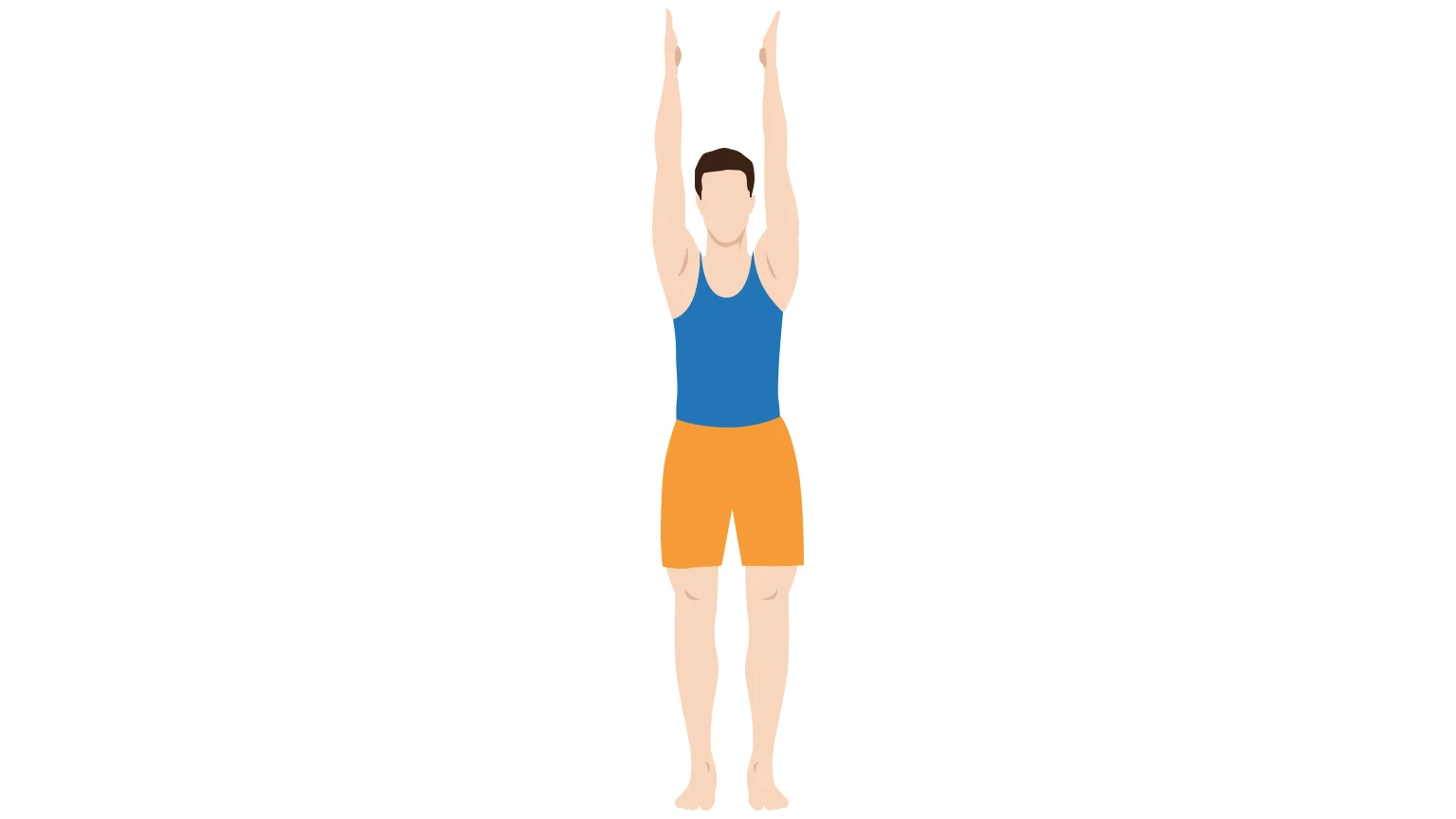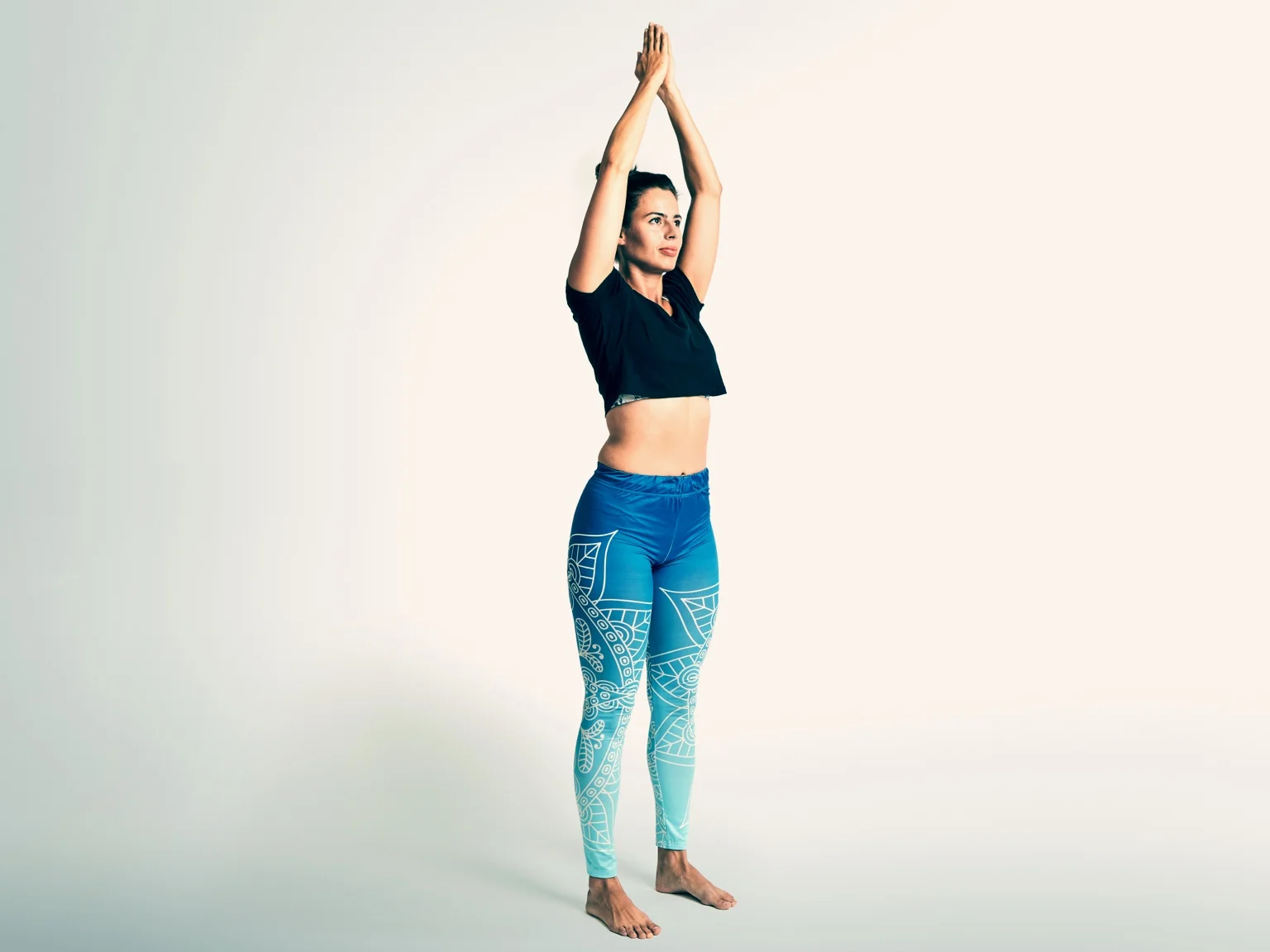Upward Salute Pose (Urdhva Hastasana, Raised Hands Pose)

The Upward Salute Pose, also known as Urdhva Hastasana or Raised Hands Pose, is a standing yoga pose. In this pose, the yogi stands upright with their feet hip-width apart. They extend their arms overhead, with their palms facing each other.
- Position: Standing.
- Stretched body parts: Abs, sides of the torso, shoulders.
- Benefits: The Upward Salute Pose is a simple pose that is a great way to warm up for other yoga exercises. The pose stretches your belly so can help with digestion.
- Symbolism: The Upward Salute Pose symbolizes a sense of reaching up towards the sky, reaching to the divine or universe. It acknowledges and embraces the vastness of the world beyond our own bodies, providing a deep sense of sense and a connection with the universe.
- Similar poses: Mountain Pose (Tadasana), Half Moon Pose (Ardha Chandrasana), Low Lunge (Anjaneyasana)
Meaning of Urdhva Hastasana
The name “Urdhva Hastasana” is derived from three Sanskrit words:
- “Urdhva” means “upward” or “raised”;
- “Hasta” means “hand”; and
- “Asana” means “pose”.
Put together, this forms the name Urdhva Hastasana, which translates literally to “Upward Hand Pose”.
How to do The Upward Salute Pose

- Start in a standing position, with your feet hip-width apart and pointing forwards (parallel to each other). Keep your arms by your sides and your gaze straight ahead.
- Take a deep breath and lift your arms up towards the sky. Keep your arms close to your ears.
- Stretch your fingers outwards. If possible, press your palms together.
- Keep your shoulders relaxed, your abs engaged and your spine long. Hold the pose for a few breaths, feeling the stretch along your spine.
- Now, exhale and slowly release from the pose. Slowly bring your arms down to your sides.
Variations
- For extra support: If you find it difficult to balance, lean your back against a wall for support. Raise your arms as you would in the traditional pose, but allow the wall to support your back and arms.
- Seated pose: You could also perform this pose seated in a chair, if you find it difficult to stand or maintain balance. Sit upright in a chair, with your feet flat on the floor, then raise your arms overhand just as you would in the standing variation.
- Bent elbows: If it’s difficult to raise your arms fully and hold them in position, try bending your elbows as your clasp your palms together.
- More challenging: To make this pose more challenging, you can try to lift your body up onto the balls of your feet while in the arms raised position.
Tips
- Be sure to synchronize your movement with your breath. Inhale as you lift up your arms and exhale as you lower them.
- Be conscious about where your feet are positioned on the ground and ensure you are distributing your bodyweight evenly between your feet.
- Don’t force your palms together if it is uncomfortable. It’s okay to keep your hands shoulder-width apart in this pose.
- When reaching upwards, do not overstretch your arms. Keep your shoulders relaxed, i.e. do not try to stretch your shoulders up towards your ears.
Prep poses
- Mountain Pose (Tadasana) – The Mountain Pose establishes the basic alignment needed for all standing poses in yoga. This pose keeps your hands lowered, but it otherwise a similar pose to the Upward Salute Pose.
- Downward Facing Dog Pose (Adho Mukha Svanasana) – The Downward Dog is a great pose for opening up your shoulders, increasing the range of motion of your arms about your shoulder. The same flexibility is required for the Upward Salute Pose.
- Cow Face Pose (Gomukhasana) – This is another pose that stretches your shoulders. It also encourages proper posture and alignment of your spine, which helps in performing the Upward Salute Pose.
